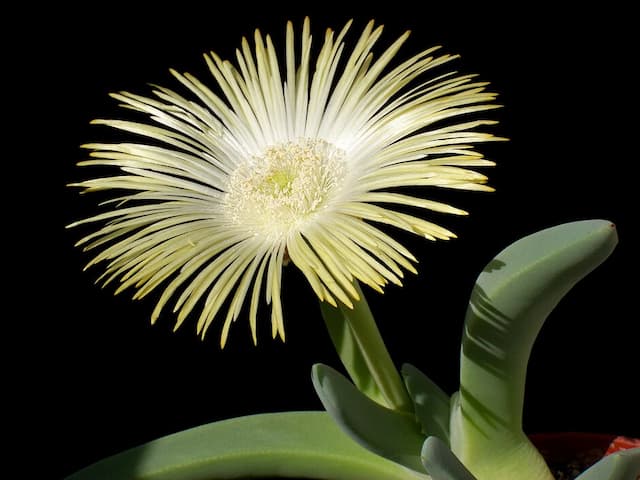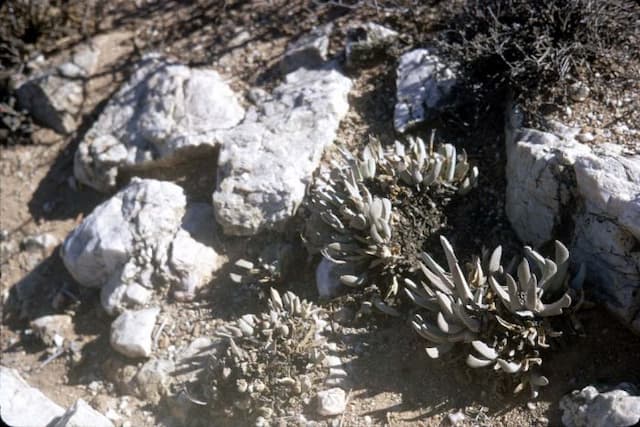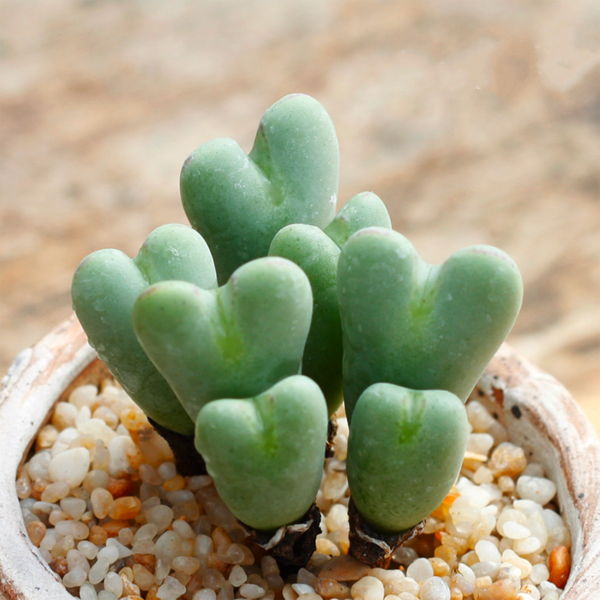Livingstone Daisy Cleretum bellidiforme

ABOUT
Cleretum bellidiforme, widely known as "Livingstone Daisy," showcases a lush, spreading growth habit that forms a mat-like appearance. This vibrant plant is adorned with succulent, spoon-shaped leaves that are fleshy and somewhat shiny, providing an attractive backdrop to the real highlight—its daisy-like flowers. The blooms present a striking array of colors, ranging from vivid whites and pinks to stunning yellows and oranges, often with a contrasting eye in the center that captivates the onlooker. These flowers typically open under the bright sun, adding a cheerful note to the scenery. The Livingstone Daisy is recognized for this dazzling floral display, which covers the foliage in a carpet of color, creating a striking visual impact in any garden setting where it is grown.
About this plant
 Names
NamesFamily
Aizoaceae
Synonyms
Bokbaaivygie, Livingstone Daisy, Bokbaai Vygie, Ice Plant
Common names
Cleretum bellidiforme
 Toxicity
ToxicityTo humans
Livingstone Daisy (Cleretum bellidiforme) is not commonly known to be toxic to humans. However, it is always advisable to exercise caution as individual allergies and reactions can occur with any plant. If ingested in large quantities or if an individual has a specific sensitivity, mild gastrointestinal discomfort could potentially ensue. As with any non-food plant, it is recommended to avoid ingesting parts of the Livingstone Daisy. To pets: Livingstone Daisy is also not widely recognized as being toxic to pets. However, the same cautions apply as with humans, as pets can also have individual sensitivities or allergies. If a pet ingested a large amount of the plant, it could potentially experience mild gastrointestinal upset, but significant toxic effects are not commonly reported. Owners should still prevent pets from consuming non-food plants to avoid any potential issues.
To pets
To humans: Livingstone Daisy (Cleretum bellidiforme) is not commonly known to be toxic to humans. However, it is always advisable to exercise caution as individual allergies and reactions can occur with any plant. If ingested in large quantities or if an individual has a specific sensitivity, mild gastrointestinal discomfort could potentially ensue. As with any non-food plant, it is recommended to avoid ingesting parts of the Livingstone Daisy. Livingstone Daisy is also not widely recognized as being toxic to pets. However, the same cautions apply as with humans, as pets can also have individual sensitivities or allergies. If a pet ingested a large amount of the plant, it could potentially experience mild gastrointestinal upset, but significant toxic effects are not commonly reported. Owners should still prevent pets from consuming non-food plants to avoid any potential issues.
 Characteristics
CharacteristicsLife cycle
Annuals
Foliage type
Deciduous
Color of leaves
Green
Flower color
Pink
Height
6 inches (15 cm)
Spread
1 foot (30 cm)
Plant type
Herb
Hardiness zones
10
Native area
South Africa
Benefits
 General Benefits
General Benefits- Ornamental Value: The plant, commonly known as Livingstone daisy, adds vibrant color and beauty to gardens and landscapes with its bright and abundant daisy-like flowers.
- Drought Tolerance: Livingstone daisy is known for its ability to withstand dry conditions, making it suitable for xeriscaping and water-efficient gardening.
- Groundcover: This plant serves as an effective groundcover, reducing soil erosion and suppressing weed growth with its dense mat-forming habit.
- Low Maintenance: Livingstone daisy is generally easy to care for, requiring minimal upkeep, which is ideal for low-maintenance gardens and busy gardeners.
- Pollinator Attraction: The flowers attract pollinators such as bees and butterflies, which are essential for the pollination of plants and a healthy ecosystem.
- Seasonal Interest: With its vivid flowering in spring and summer, Livingstone daisy provides seasonal interest and vibrant colors during its blooming period.
- Coastal Adaptation: This plant is well-adapted to coastal areas, tolerating salt spray and sandy soils, making it an ideal choice for seaside gardens.
- Container Gardening: Its compact size and cascading habit make Livingstone daisy suitable for container gardening, adding mobility and versatility in garden design.
- Edible Flowers: The blossoms of Livingstone daisy can be eaten and are sometimes used as a colorful garnish in salads and culinary presentations.
- Fast Growing: It grows quickly, providing rapid coverage and gratification in garden spaces or when used for seasonal displays.
 Medical Properties
Medical PropertiesThis plant is not used for medical purposes.
 Air-purifying Qualities
Air-purifying QualitiesThis plant is not specifically known for air purifying qualities.
 Other Uses
Other Uses- Livestock forage: Cleretum bellidiforme, also known as Livingstone daisy, can be used as a supplemental forage for livestock due to its drought tolerance.
- Dye production: The vibrant flowers of the Livingstone daisy can be used to create natural dyes for fabrics or handicrafts.
- Garden borders: With its low-growing, mat-forming habit, Livingstone daisy is ideal for creating colorful borders in gardens and walkways.
- Erosion control: The dense foliage and rooting system of Livingstone daisy can help stabilize soil and prevent erosion on sloped landscapes.
- Floral arrangements: Fresh or dried flowers of the Livingstone daisy can be used in floral arrangements or bouquets for their vivid colors.
- Educational tool: In school gardens, Livingstone daisy can be used as a tool to teach children about plant growth and care due to its easy cultivation.
- Craft projects: Dried flowers of the Livingstone daisy can be used in craft projects, such as making bookmarks, cards, or potpourri.
- Ground cover: Livingstone daisy plants are an excellent ground cover option for sunny, dry areas where other plants may struggle to thrive.
- Pollinator attraction: The bright flowers of the Livingstone daisy are attractive to bees, butterflies, and other pollinators, enhancing biodiversity.
- Photography subject: With their striking colors, Livingstone daisies can provide an excellent subject for photographers, particularly macro photography enthusiasts.
Interesting Facts
 Feng Shui
Feng ShuiThe Livingstone daisy is not used in Feng Shui practice.
 Zodiac Sign Compitability
Zodiac Sign CompitabilityThe Livingstone daisy is not used in astrology practice.
 Plant Symbolism
Plant Symbolism- Delicacy - The Livingstone daisy (Cleretum bellidiforme) has tender, delicate petals that easily bruise and wilt, symbolizing the fragile nature of life and relationships.
- Cheerfulness - With its bright and varied colors, the Livingstone daisy represents joy and positivity, bringing a cheerful ambiance to gardens.
- Perseverance - The plant’s ability to thrive in sandy, dry, and coastal conditions is often emblematic of resilience and the capacity to endure challenging situations.
 Water
WaterLivingstone daisies require moderate watering, ideally when the top inch of soil feels dry to the touch. Water thoroughly, allowing excess water to drain out of the pot, usually every 7-10 days, depending on the climate and indoor conditions. During the growing season, Livingstone daisies may need water slightly more often, every 5-7 days, but be cautious not to overwater. Provide roughly 8-16 ounces per watering to ensure the roots are sufficiently moistened without becoming waterlogged. Adjust the amount based on the size of the pot; larger pots may require up to 32 ounces.
 Light
LightLivingstone daisies thrive best in full sunlight conditions, making them ideal for a spot that receives at least 6 to 8 hours of direct sunlight daily. They can tolerate some light shade, especially in hotter climates where the afternoon sun might be too intense. A south-facing window or a spot in the sunny part of the garden will provide the light conditions needed for the Livingstone daisy to flourish.
 Temperature
TemperatureThe ideal temperature range for Livingstone daisies is between 60°F and 75°F. They can tolerate temperatures as low as 40°F and as high as 90°F, but prolonged exposure outside this range can be detrimental to the plant's health. To ensure optimal growth, protect the plant from extreme temperatures and avoid placing it in areas where there are cold drafts or excessive heat.
 Pruning
PruningPrune Livingstone daisies to remove spent flowers and encourage bushier growth; this is best done after a flowering cycle ends. You can lightly prune throughout the growing season as needed. Pruning is generally not required frequently but removing old flowers can stimulate new blooms. The best time to prune heavily, if needed, is in early spring before new growth begins.
 Cleaning
CleaningAs needed
 Soil
SoilLivingstone Daisy, or Cleretum bellidiforme, thrives best in a sandy, well-draining soil mix with a slightly acidic to neutral pH of 5.5 to 7.5. A mixture combining two parts sand or perlite with one part peat or coconut coir can create an ideal environment for root health and moisture balance.
 Repotting
RepottingLivingstone Daisies should be repotted every one to two years to refresh the soil and accommodate root growth. However, as these are annuals, repotting is often not necessary unless they are overwintered or grown as perennials in climates without frost.
 Humidity & Misting
Humidity & MistingLivingstone Daisy prefers moderate humidity levels but is quite adaptable and can tolerate dry air. It's best to aim for a humidity level around 40-50%, which is typically the average indoor humidity range.
 Suitable locations
Suitable locationsIndoor
Place Livingstone Daisy in a sunny spot with well-draining soil.
Outdoor
Plant in full sun, in sandy soil, and protect from frost.
Hardiness zone
9-11 USDA.
 Life cycle
Life cycleThe life cycle of Cleretum bellidiforme, commonly known as Livingstone Daisy, begins with seed germination, occurring when conditions are warm and moist. Seedlings emerge with cotyledons, soon followed by the growth of true leaves and developing a rosette-like structure. As the plant matures, it develops a sturdy stem and vibrant, daisy-like flowers, typically during late spring or early summer. After pollination, which is assisted by insects attracted to the flowers, the plant sets fruit, producing capsules filled with tiny seeds. When the seeds mature, they are dispersed by wind, water, or animals, and upon finding a suitable environment, they lie dormant until the next favorable season for germination. The Livingstone Daisy completes its life cycle annually, dying after the seeds have been shed, but leaving behind a new generation to sprout during the next suitable growth period.
 Propogation
PropogationPropogation time
Spring to Summer
The most popular method for propagating Livingstone daisy (Cleretum bellidiforme) is through seed. The best time for sowing these seeds is in early spring in trays of seed starting mix. Sprinkle the tiny seeds on the surface and gently press them into the moist soil, as they need light to germinate. Covering the tray with clear plastic wrap or a propagator lid can help maintain humidity. Place the tray in a warm area with temperatures around 70°F (21°C). Germination should occur within 7 to 14 days, after which you can remove the cover and move the seedlings to a bright, indirect light location until they are large enough to handle and eventually transplant outdoors after the risk of frost has passed.

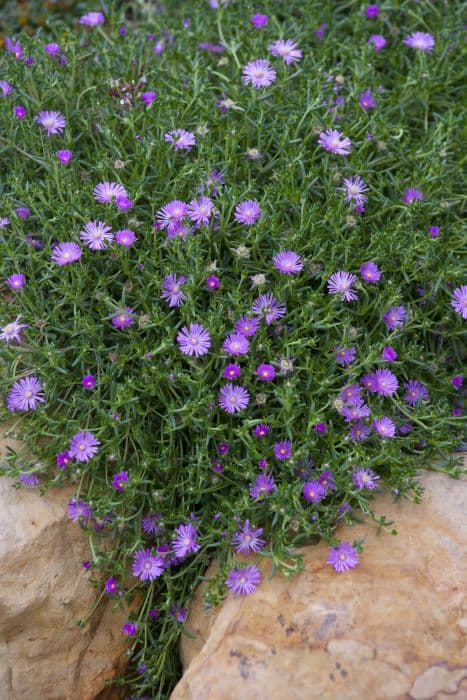
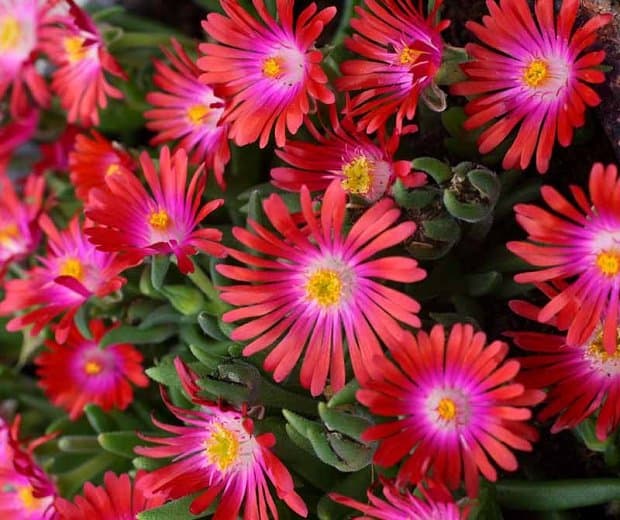
![Ice plant [Fire Spinner]](/_next/image?url=https%3A%2F%2Fplants-admin.emdemapps.com%2Fimages%2Fplants%2F%2Fimages%2F604b54d98722a.png&w=640&q=75)



